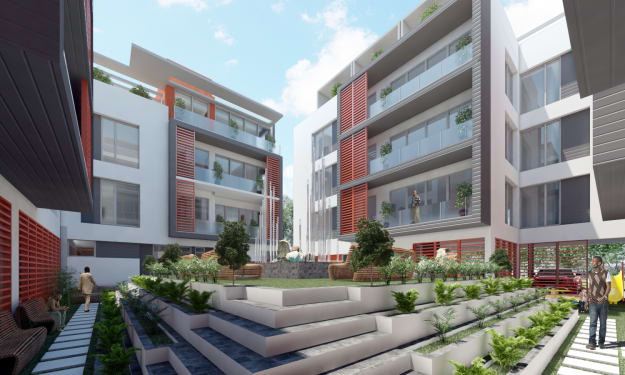
- BIM: An Introduction - BIM: The Evolution - BIM: Software/Applications - BIM: Processes - BIM: Implementation Strategies - BIM: Shaping the Future of Construction
INTRODUCTION
Building Information Modeling (BIM) is an intelligent 3D model-based process that equips architecture, engineering, and construction professionals with the insight and tools to plan, design, construct, and manage buildings and infrastructure projects more efficiently.
Building Information Modeling (BIM) software and applications are tools that enable the project team make more informed design decisions, build more efficiently and cost-effectively, as well as manage and maintain buildings with greater ease.
A BIM model consists of
- The virtual equivalents of the real building components used to construct a building. - An intelligent digital prototype of the physical building elements. - Building components with all physical and logical characteristics of their real counterparts. - BIM tools enable simulations of the building and its context to understand its behavior.
Uncoordinated information is the major source of wastes on building and infrastructure projects.
The adoption of Building Information Modeling facilitates effective coordination of production information amongst Project and Production teams ensuring;
- 20% reduction in build costs. - 33% reduction in through-life of the building. - 47% - 65% reduction in conflicts and variations. - 44% - 59% improvement in overall project quality. - 35% - 43% reduction in risk, better predictability. - 34% - 40% better performing completed projects. - 32% - 38% improvement in review and approval cycles.
* UK Government Cabinet Office BIM Strategy Paper
BIM envisages virtual construction of a project prior to its actual physical construction, in order to reduce uncertainty, improve safety, resolve potential problems, and simulate and analyse potential impacts.
EVOLUTION
The concept of BIM had existed since the 1970s however the term ‘Building Information Model’ first appeared in a 1992 paper by G.A. Van Nederveen and F. P. Tolman.
In 2002, Autodesk released a white paper entitled 'Building Information Modeling' after which other software vendors also started to assert their involvement in the field.
Autodesk, Bentley Systems and Graphisoft, helped popularise and standardize the term as a common name for the digital representation of the building process.
Prior to the adoption of BIM as a common term, terms used by software vendors were;
Graphisoft -“Virtual Building” Bentley Systems - “Integrated Project Models” Autodesk - “Building Information Modeling”
ArchiCAD is regarded by some as the first implementation of BIM because in 1987, ArchiCAD launched a CAD product on a personal computer that was able to create both 2D and 3D geometry
The Evolution of BIM could be attributed to the AEC (Architecture Engineering and Construction) industry’s (World Biggest Industry) seeming lack of automation and efficiency when compared to other industries especially the Automobile and Manufacturing.
The major source of inefficiency in the AEC industry is the low level of integration and information sharing amongst AEC professionals leading to wastes.
Latham Report (UK) titled ‘Constructing the Team’- 1994 identified industry inefficiencies, condemning existing industry practices as;
- ‘Adversarial’ - ‘Ineffective’ - ‘Fragmented’ - ‘Incapable of delivering value for its clients’.
Latham Report advocated partnering and collaboration within the AEC industry.
A follow up to Latham Report was the Egan Report (UK) Rethinking Construction- 1998, was informed by experiences in other industries, notably Manufacturing as it sought to improve performance through eliminating wastes from the construction process by recommending;
- Committed leadership - A focus on the customer - Integrated processes and teams - A quality driven agenda, and - Commitment to people
Lean Construction provided the tools recommended by Egan Report as it is a Construction Management principle that focuses on zero wastes emanating from the construction process by ensuring;
- Clear Project Value Definition/ Brief Taking - Concurrent Processing - Product Focus/ Continuous Value Flow - Just In time Delivery Of Resources - Continuous Improvement (Pursue Perfection)
Some of Lean Construction’s implementation tools are Partnering and Supply Chain Management /the evolution Logistic Hubs.
UK Government initiatives, notably the drive from 2010 onwards, focused on the implementation Building Information Modeling on all UK Public Sector Construction projects facilitated the general adoption of BIM on all projects (Public and Private).
BIM is therefore considered a tool, method, and/or technique that assist in fulfilling the aims of Lean Construction, it is considered an integral part of the toolkit available for its adoption and it’s called ‘LEAN DESIGN’.
SOFTWARE AND APPLICATIONS
Architecture
- Autodesk Revit Architecture - Graphisoft ArchiCAD - Nemetschek Allplan Architecture - Gehry Technologies - Digital Project Designer - Nemetschek Vectorworks Architect - Bentley Architecture - 4MSA IDEA Architectural Design (IntelliCAD) - CADSoft Envisioneer - Softtech Spirit - RhinoBIM (BETA)
Structures
- Autodesk Revit Structure - Autodesk Robot Structural Analysis - Bentley Structural Modeler - Bentley RAM, STAAD and ProSteel - Tekla Structures - CypeCAD - Graytec Advance Design - StructureSoft Metal Wood Framer - Nemetschek Scia - 4MSA Strad and Steel
Mechanical Electrical & Plumbing (MEP)
- Autodesk Revit MEP - Bentley Hevacomp Mechanical Designer - 4MSA FineHVAC+FineLIFT+FineELEC+FineSANI - Gehry Technologies - Digital Project MEP Systems Routing - CADMEP (CADduct /CADmech)
Construction (Simulation, Estimating and Construction Analysis)
- Autodesk Navisworks - Solibri Model Checker - Vico Office Suite - Vela Field BIM - Bentley ConstrucSim - Tekla BIMSight - Glue (by Horizontal Systems) - Synchro Professional - Innovaya
Sustainability
- Autodesk Ecotect Analysis - Autodesk Green Building Studio - Graphisoft EcoDesigner - IES Solutions Virtual Environment VE-Pro - Bentley Tas Simulator - Bentley Hevacomp - DesignBuilder
Facility Managment
- Bentley Facilities - FM: Systems FM: Interact - Vintocon ArchiFM (For ArchiCAD) - Onuma System - EcoDomus
Cost Estimates/ Quantities
- Sigma - CostX - Vico
PROCESSES
Production of Drawings, Models and Visualisations- 3D Design Simulations- 4D Specifications and Quantities- 5D Procurement Product and Price Database- 5D Construction Management- 5D Facilities Management- 6D/7D
7D BIM or Facility Management Application is regarded as 6D by some software vendors who may not have provided the capacity for sustainability analysis (i.e. 6D) in their software.
IMPLEMENTATION
- Management’s Commitment to BIM/ Planning - Procurement of Software/ Enabling IT Infrastructure - Motivation and Training Staff (JIT) - Transfer of existing CAD Standards to BIM Standards - Execution of a Sample Project - Identify and Reward Proficiencies - Monitoring and Periodical Review of Progress
SHAPING THE FUTURE OF CONSTRUCTION
BIM is a viable tool that effectively reduces the Through-Life Cost of Construction Projects through the effective integration of Production Information, Standardization and Lean Working while facilitating Continuous Improvement/Best Practices and efficient Collaboration.
About the Creator
'Sola IGE
An Architect/Construction Manager driven by a passion for great designs, highest quality standards and an enthusiastic pursuit of excellence, focused on delivering added value and the elimination of wastes in the project delivery process.
Enjoyed the story? Support the Creator.
Subscribe for free to receive all their stories in your feed. You could also pledge your support or give them a one-off tip, letting them know you appreciate their work.






Comments (2)
Well Articulated from the BIM Guru him self, the world is quickly changing with new innovative solutions to our daily challenges, with the introduction of AI in design and construction, one can only Guess the extent/direction technology will take us in the nearest feature.
An insightful write-up. It succinctly captures what needs to be known about BIM.